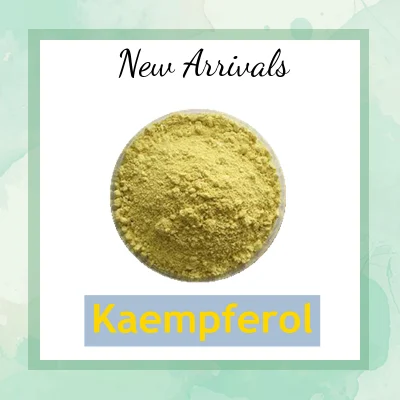Basic Info.
Product Description


Product Name | Kaempferia galanga(rhizoma kaempferiae powder extract | Latin Name | Hedychium Coronarium |
Place of Origin | China | Part Used | root |
Active Ingredient | Kaempferol | Specification | 98% |
Appearance | Yellow fine powder | Testing Method | HPLC |
CAS | 520-18-3 | Molecular formula | C15H10O6 |


| Analysis | Specification | Results |
| Assay | Kaempferol ≥98% | 98.30% |
| Appearance | Pale Yellow powder | Complies |
| Heavy metals | ≤20ppm | Complies |
| Pb | ≤5.0ppm | Complies |
| As | ≤3.0ppm | Complies |
| Ignition residue | ≤5.0% | 2.35% |
| Loss on drying | ≤10.0% | 6.86% |
| Mesh Size | 95% pass 80 mesh | Complies |
| Resin | Negative | Complies |
| Total of bacteria | ≤1000cfu/g | Complies |
| Fungi | ≤100cfu/g | Complies |
| Salmgosella | Negative | Complies |
| Coli | Negative | Complies |
| Storage | Store in cool & dry place. Keep away from strong light and heat. | |
| Shelf life | 2 years when properly stored | |

1. Hypoglycemic and antioxidant effects
In the investigation of the effects of kaempferol-3,7-O-(alpha)-dirhamnoside (kaempferitrin) on serum glucose levels for its antioxidant potential and hypoglycemic effect found that the hypoglycemic effect of kaempferitrin in diabetic rats was evident at all doses tested.
2. Anti-inflammatory effects
In the evaluation of Kaempferol-3-O-sophoroside (KPOS), isolated from the leaves of cultivated mountain ginseng and its Anti-inflammatory effects, found that that KPOS possesses barrier integrity activity, inhibitory activity on cell adhesion and migration to endothelial cells by blocking the activation of NF-κB expression and production of TNF-α.
3. Antimicrobial effect
In the observation of kaempferol, myricetin, naringin, and rutin were the major flavonoids present in the pericarp and theirs antimicrobial effect found that the anti fungi activity was only found in seed extract against Aspergillus niger (1.87 cm) at concentration of 0.3 mg/well. From the results obtained, P. macrocarpa fruit could be considered as a natural antimicrobial source due to the presence of flavonoid compounds.
4. Cardioprotective effect
In the analyzing the LGP consisted of 92% carbohydrate and was rich in flavans, anthocyanins, quercetin, myricetin, kaempferol, and resveratrol and it effect in cardiovascular diseases found that through alterations in lipoprotein metabolism, oxidative stress, and inflammatory markers, LGP intake beneficially affected key risk factors for coronary heart disease in both pre- and postmenopausal women.
5. Neuroprotective effects
In the investigationthe neuroprotective effects of kaempferol in the mouse model of Parkinson's disease found that kaempferol could prevent the loss of TH-positive neurons







